abit AB9 QuadGT: Test Lab Update
by Gary Key on February 21, 2007 10:00 AM EST- Posted in
- Motherboards
Dual Core Overclocking
We have received countless requests regarding how various memory modules perform in our motherboard tests with an emphasis on overclocking results. Our opinion is that unless you are benchmarking professionally or have a burning desire to have the absolute latest and fastest then most DDR2-800 memory is suitable for the majority of users. The performance differences in application scores are typically minimal as we will show shortly and in the near future. We will be expanding the types of memory modules we utilize in future motherboard testing but for today we decided to show results on this board with a couple of different modules.
We start with some of Corsair's finest Micron based memory, the TWIN2x2048-6400C3. Although this memory is not part of the new Dominator family, we have found that it still overclocks extremely well while offering low latency timings. This memory is being replaced by the Dominator TWIN2X2048-6400C3DF that currently retails for around $460 for 2GB. The base timing supported by either memory is 3-4-3-9 at DDR2-800. We have found in testing that at 2.20V timings of 3-3-3-9 are achievable on the abit board.
Our testing did not reveal any real differences in performance between each beta BIOS release. abit says they will be working on fine tuning this board once the original set of problems are fixed. We were able to operate our GEIL memory with 4-4-4-12 timings at 2.4V up to a final overclock of 7x515. These results did not change with the B06 BIOS. However, we were able to reach a final benchmark stable setting of 7x520 at 4-4-3-9 timings with the Corsair memory set at a 1:1 ratio resulting in DDR2-1040 clock speeds.
Our next set of performance oriented DDR2-800 memory comes from G.Skill and is designed for the enthusiast on a budget. The F2-6400CL4D-2GBHK is a 2GB kit featuring DDR2-800 speeds with 4-4-3-5 timings at 2.10V. The modules are based on Promos ICs with a current street price of $200.00. We were able to consistently run the stated DDR2-800 based timings at 2.10V on the abit board.
In fact, we were able to run 3-4-4-10 timings at DDR2-800 at 2.20V in all benchmarks except our Quake 4 benchmark that repeatedly failed unless we changed the CAS setting to 4. We were able to reach a final benchmark stable setting of 7x520 at 4-4-4-10 timings with the G.Skill memory set at a 1:1 ratio resulting in DDR2-1040 clock speeds. Voltage had to be increased to 2.275V which we feel is near the upper limit on Promos based modules. We were very impressed with this particular G.Skill memory product and pricing considering the initial performance results we have witnessed on several boards already. We will now look at the maximum memory speeds our modules were able to reach on the abit QuadGT.
Our original GEIL Ultra memory was able to reach a top speed of DDR2-1163 at 5-6-5-15 timings with 2.4V. We found during testing that our particular board would not exceed DDR2-1163 speeds regardless of memory timings or voltages. Our Corsair memory was able to achieve memory speeds of DDR2-1150 with 5-5-4-12 timings and fairly aggressive sub-timings on this board at 2.40V. The G.Skill memory topped out at a stable DDR2-1075 with 5-5-5-13 timings at 2.275V. We have found the G.Skill memory has averaged anywhere from DDR2-1030 up to DDR2-1100 and the Corsair from DDR2-1120 up to DDR2-1220 on other boards.
Quad Core Overclocking
We also received several requests for quad core performance on this board. We have not completed overclocking testing with various memory modules but are glad to report that we were able to reach a final benchmark stable setting of 8x450FSB on the board with our Corsair memory set at a 1:1 ratio, resulting in a final speed of DDR2-900 with 3-4-4-9 timings. We could POST and enter XP at an 8x465FSB setting but the board was not stable. Dropping the multiplier down to 7 or even 6 resulted in POST numbers up to 480FSB but we did not find the board to be stable past a 7x455FSB setting with our quad core processor after extensive stability testing. We will present additional quad core performance results in our upcoming Gigabyte GA-N680SLI-DQ6 article.
| abit AB9 QuadGT Dual Core Overclocking |
|
| Processor: | Intel Core 2 Duo E6300 Dual Core, 1.86GHz, 2MB Unified Cache 1066FSB, 7x Multiplier |
| CPU Voltage: | 1.4850V (default 1.3250V) |
| Cooling: | Tuniq Tower 120 |
| Power Supply: | OCZ GameXStream 700W |
| Memory: | Corsair TWIN2x2048-6400C3 (2x1GB) (Micron Memory Chips) GSkill PC2-6400 (2x1GB, F2-6400CL4-1GBHK) (Promos Memory Chips) |
| Video Cards: | 1 x MSI X1950XTX |
| Hard Drive: | Seagate 320GB 7200RPM SATA2 16MB Buffer |
| Optical Drive: | Sony 18X AW-Q170A-B2 |
| Case: | Cooler Master CM Stacker 830 |
| Maximum CPU OC: | 520x7 (4-4-3-9, 1:1, 2.400V), CPU 1.4850V 3640MHz (+95%) - Corsair 520x7 (4-4-4-10, 1:1, 2.275V), CPU 1.4850V 3640MHz (+95%) - G.Skill |
| . | |
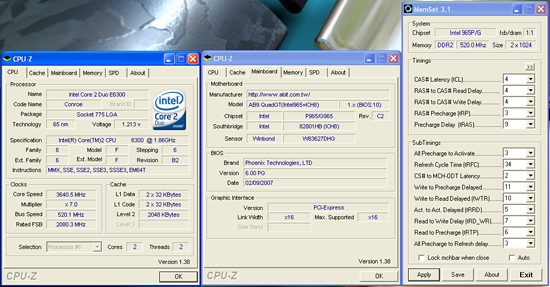 |
| Click to enlarge |
We have received countless requests regarding how various memory modules perform in our motherboard tests with an emphasis on overclocking results. Our opinion is that unless you are benchmarking professionally or have a burning desire to have the absolute latest and fastest then most DDR2-800 memory is suitable for the majority of users. The performance differences in application scores are typically minimal as we will show shortly and in the near future. We will be expanding the types of memory modules we utilize in future motherboard testing but for today we decided to show results on this board with a couple of different modules.
We start with some of Corsair's finest Micron based memory, the TWIN2x2048-6400C3. Although this memory is not part of the new Dominator family, we have found that it still overclocks extremely well while offering low latency timings. This memory is being replaced by the Dominator TWIN2X2048-6400C3DF that currently retails for around $460 for 2GB. The base timing supported by either memory is 3-4-3-9 at DDR2-800. We have found in testing that at 2.20V timings of 3-3-3-9 are achievable on the abit board.
Our testing did not reveal any real differences in performance between each beta BIOS release. abit says they will be working on fine tuning this board once the original set of problems are fixed. We were able to operate our GEIL memory with 4-4-4-12 timings at 2.4V up to a final overclock of 7x515. These results did not change with the B06 BIOS. However, we were able to reach a final benchmark stable setting of 7x520 at 4-4-3-9 timings with the Corsair memory set at a 1:1 ratio resulting in DDR2-1040 clock speeds.
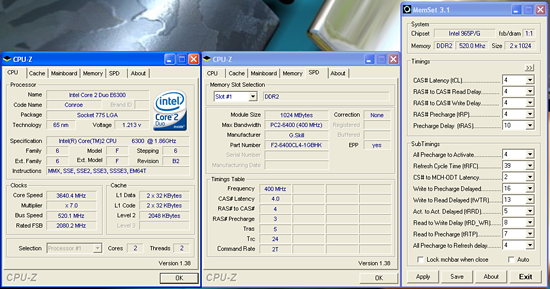 |
| Click to enlarge |
Our next set of performance oriented DDR2-800 memory comes from G.Skill and is designed for the enthusiast on a budget. The F2-6400CL4D-2GBHK is a 2GB kit featuring DDR2-800 speeds with 4-4-3-5 timings at 2.10V. The modules are based on Promos ICs with a current street price of $200.00. We were able to consistently run the stated DDR2-800 based timings at 2.10V on the abit board.
In fact, we were able to run 3-4-4-10 timings at DDR2-800 at 2.20V in all benchmarks except our Quake 4 benchmark that repeatedly failed unless we changed the CAS setting to 4. We were able to reach a final benchmark stable setting of 7x520 at 4-4-4-10 timings with the G.Skill memory set at a 1:1 ratio resulting in DDR2-1040 clock speeds. Voltage had to be increased to 2.275V which we feel is near the upper limit on Promos based modules. We were very impressed with this particular G.Skill memory product and pricing considering the initial performance results we have witnessed on several boards already. We will now look at the maximum memory speeds our modules were able to reach on the abit QuadGT.
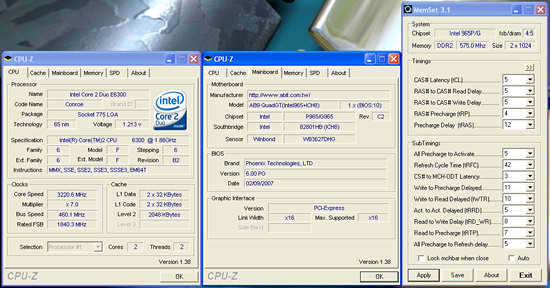 |
| Click to enlarge |
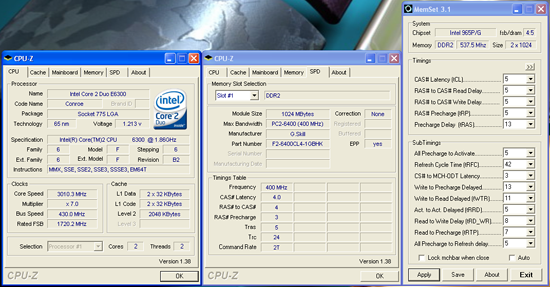 |
| Click to enlarge |
Our original GEIL Ultra memory was able to reach a top speed of DDR2-1163 at 5-6-5-15 timings with 2.4V. We found during testing that our particular board would not exceed DDR2-1163 speeds regardless of memory timings or voltages. Our Corsair memory was able to achieve memory speeds of DDR2-1150 with 5-5-4-12 timings and fairly aggressive sub-timings on this board at 2.40V. The G.Skill memory topped out at a stable DDR2-1075 with 5-5-5-13 timings at 2.275V. We have found the G.Skill memory has averaged anywhere from DDR2-1030 up to DDR2-1100 and the Corsair from DDR2-1120 up to DDR2-1220 on other boards.
Quad Core Overclocking
| abit AB9 QuadGT Quad Core Overclocking |
|
| Processor: | Intel Core 2 Extreme QX6700 Quad Core, 2.66GHz, 8MB Unified Cache 1066FSB, 10x Multiplier |
| CPU Voltage: | 1.400V (default 1.350V) |
| Cooling: | Tuniq Tower 120 |
| Power Supply: | OCZ ProXStream 1000W |
| Memory: | Corsair TWIN2x2048-6400C3 (2x1GB) (Micron Memory Chips) |
| Video Cards: | 1 x MSI 8800GTX |
| Hard Drive: | Seagate 320GB 7200RPM SATA2 16MB Buffer |
| Optical Drive: | Plextor PX-760A |
| Case: | Cooler Master CM Stacker 830 |
| Maximum FSB OC: | 450x8 (3-4-4-9, 1:1, 2.400V), CPU 1.400V 3600MHz (+35%) |
| . | |
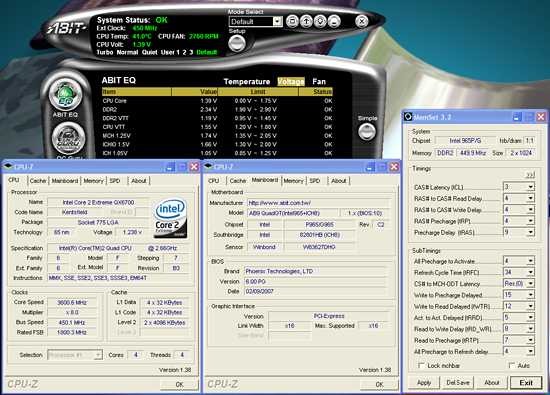 |
| Click to enlarge |
We also received several requests for quad core performance on this board. We have not completed overclocking testing with various memory modules but are glad to report that we were able to reach a final benchmark stable setting of 8x450FSB on the board with our Corsair memory set at a 1:1 ratio, resulting in a final speed of DDR2-900 with 3-4-4-9 timings. We could POST and enter XP at an 8x465FSB setting but the board was not stable. Dropping the multiplier down to 7 or even 6 resulted in POST numbers up to 480FSB but we did not find the board to be stable past a 7x455FSB setting with our quad core processor after extensive stability testing. We will present additional quad core performance results in our upcoming Gigabyte GA-N680SLI-DQ6 article.










8 Comments
View All Comments
Jodiuh - Thursday, February 22, 2007 - link
Remember that board? I fell in love w/ that and the IC7, AS8, and AA8XE. When will we see a nice C2D board from DFI?Lord 666 - Wednesday, February 21, 2007 - link
Have they given any time frame to get the next official BIOS out? Love this board, but disappointed with abit's slow release schedule.Still using the 1.0 release. Bored last night and connected my OS Drive Raptor 150 that was normally setup using ICH8R in IDE mode to the JMicron eSATA connection. Much faster booting when doing the "reach around" with cable to the eSATA when compared to the ICH8R in IDE/ACHI/RAID.
RAID issues did not affect my build since using a 3Ware 9650SE-4 card with 3x Raptor 150s in RAID 5.
Overall, good board.
Hlafordlaes - Wednesday, February 21, 2007 - link
I am posting from an overclocked Abit VP6 dual P-III, which I have tweaked quite a bit. It is stable, and fast enough for me to play Oblivion happily on high settings (6800U vid card).Abit's commitment to quality support seems real from the article and from other forums, and the new Universal funding should help, too. And I like the all-solid caps.
This board is on my short list for purchase. (The PCI slot issue raised above will not affect my planned use.)
sprockkets - Wednesday, February 21, 2007 - link
reviewing the abit nfs2 6150 AMD AM2 board soon?Zak - Wednesday, February 21, 2007 - link
Exactly. What the hell is with mobo designs/layouts these days? They're awful. Besides, after several disasters couple of years ago I wouldn't touch Abit board even if it was free. Z.MadAd - Wednesday, February 21, 2007 - link
*sigh* another board that, with any decent vid card in slot2, has only 1 workable PCI slot. Great.....NOT.JarredWalton - Wednesday, February 21, 2007 - link
Theoretically, if you utilize all seven expansion card slots, you could have a CrossFire dual-slot GPU configuration and still get 3 expansion slots open. The problem is, moving the top GPU slot up that far interferes with HSFs, RAM, etc. and pretty much no one does it anymore. So for people that want two dual-slot GPUs, they will get two open expansion slots, and the mobo makers have to decide whether they want a shortsighted PCI-only layout or one each of PCI and PCI-E.Personally, I just wish more boards used X16 slots on all PCI-E connections, even if they're only X1 data paths. Very few people I know plan on having high-end CrossFire (or SLI) plus sound card plus PCI TV tuner. People that run CrossFire usually aren't worried about TV tuners, because they have a relatively noisy gaming PC. HTPC people that use TV tuners usually only need one GPU, and often not anything more than X1650 or GeForce 7600 class.
Long term, we are going to see more parts move to PCI-E slots, and then people will start to complain about board layouts that waste space on PCI slots. Damned if you do, damned if you don't.... ;)
Geraldo8022 - Wednesday, February 21, 2007 - link
don't these companies do ANY simple real world testing of these boards before release? How hard would it be for one of the employees to build a computer using the prototype board and use it at home for a week or two to see if it can actually function? There must be thousands of AnandTech readers who would volunteer for free to test these boards for them. It just makes no sense.